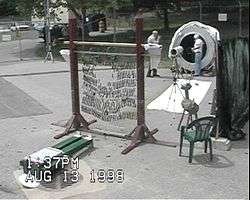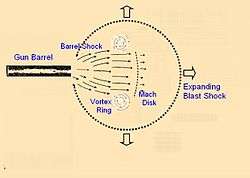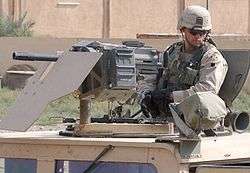Vortex ring gun

The vortex ring gun is an experimental non-lethal weapon for crowd control that uses high-energy vortex rings of gas to knock down people or spray them with marking ink or other chemicals.
The concept was explored by the US Army starting in 1998, and by some commercial firms. Knockdown of distant individuals currently seems unlikely even if the rings are launched at theoretical maximum speed.[1] As for the delivery of chemicals, leakage during flight is still a problem.
Weapons based on similar principles but different designs and purposes have been described before, typically using acetylene-air or hydrogen–oxygen explosions to create and propel the vortices.[2]
Operation



In a typical concept, a blank cartridge is fired into a gun barrel that has a diverging nozzle screwed onto the muzzle.[3] In the nozzle, the short pulse of high pressure gas briefly accelerates to a supersonic exit velocity, whereupon a portion of the exhaust transforms from axial flow into a subsonic, high spin vortex ring with the potential energy to fly hundreds of feet.[4][5]
The nozzle of a vortex ring gun is designed to both contain the short pulse of accelerating gas until the maximum pressure is lowered to atmospheric and to straighten the exhaust into an axial flow.[6] The objective is to form the vortex ring with the highest possible velocity and spin by colliding a short pulse of a supersonic jet stream against the relatively stagnant air behind the spherically expanding Blast Shock. Without the nozzle, the high pressure jet stream is reduced to atmospheric by standing shock waves at the muzzle, and the resulting vortex ring is not only formed by a lower velocity jet stream but also degraded by turbulence.[7]
History
The 1998 US Army project
The United States Army Research Laboratory was asked by the Marine Corps Joint Non-Lethal Weapons Directorate to determine whether vortex rings could be used for non-lethal crowd control. Overall management authority for the study was assigned to the United States Army Materiel Command, with support by ARDEC. Contributors to the study included individuals from the US Army's Aberdeen Proving Grounds, Adaptive Research Incorporated, Berkeley Research Associates, EWS Limited, Johns Hopkins University, Pennsylvania State University, Sara Corporation, and Sonic Development Laboratory.[8]

The end product was to be a kit for quickly converting an existing lethal weapon to a non-lethal vortex ring generator that could knock-down an individual or spray him with a dye, malodorous chemical, or incapacitating chemical. The kit, consisting of a nozzle with chemical reservoirs and belts of blank 40mm cartridges modified to detonate at pressures up to 100,000 psi (690 KN/sqN), was being designed for the Navy MK19-3.[9] The 40mm grenade machine gun was selected because firing at 4-10 shots per second resonates with many body parts and causes a stronger impact effect.[10]
Single shot field tests performed without optimized nozzles led to the conclusion vortex rings were unsuitable for non-lethal crowd control. This conclusion was reached partly because knock down did not appear to be feasible at the desired range of 100 feet (30 m), partly because of the excessive spillage onto bystanders under the flight path if used to transport chemicals or dyes, and partly because the flight noise and speed enabled it to be easily avoided at the downrange target.[11][12] The foremost reliability issue with this project was turbulence caused by the high-energy propellant burning outside the barrel.
The Hail cannon
Later commercial solutions overcame some problems of the US Army concept by using less energetic gas propellants through the re-purpose of the Hail cannon which reliably fires vortex rings at one third the speed of sound or better.[13] (Note that Hail cannons have been in use for over a century and do not themselves qualify as "later commercial designs".)
References
- ↑ Video of knock down tests on YouTube
- ↑ "Faulker Feuersturm" by Rob Arndt: "Dr. Zippermeyer ... designed and built a series of highly unorthodox anti-aircraft weapons ... Dr. Zippermeyer constructed both a huge Wirbelwind Kanone (Whirlwind Cannon) and Turbulenz Kanone (Vortex Cannon). ... used a detonation of hydrogen and oxygen ..."
- ↑ "Defense Update," Qadima Israel internet magazine overview of the Vortex ring Gun.
- ↑ George K. Lucey Jr., Vortex Ring Generator: Mechanical Engineering Design For 100Kpsi Operating Pressures, ARL-TR-2096, United States Army Research Laboratory, Adelphi, MD, January 2000 --- Includes equations and test results for a prototype vortex ring generator simulating a MK19 40mm grenade launcher.
- ↑ "Vortex / Hail Cannon . Welland Steam and Country Rally 2010". YouTube. Retrieved 7 October 2014.
- ↑ Dr. John D. Anderson, Jr., "Modern Compressible Flow With Historical Perspective," Second Edition, 1990 McGraw Hill Inc., NY, NY, pp 182-183, 327-329.
- ↑ Daniel L. Clear, et al., "Computational Fluid Dynamics Application To Gun Muzzle Blast - a Validation Case Study," Technical Report ARCCB-TR-03011, August 2003, US Army Armament Research Development And Engineering Center, Picatinny, NJ, Pages 6-7.
- ↑ Lucey, G & Jasper, L., Vortex Ring Generator, United States Army Research Laboratory, Adelphi, MD 1998. NLD III Conference, 25 February 1998, Johns Hopkins Applied Physics Lab., pp 1,41 -- Management description of the desired configuration, potential uses, performance requirements, technology gaps to overcome, and partners from academe, industry, and government.
- ↑ George K. Lucey Jr., Vortex Ring Generator: Mechanical Engineering Design For 100Kpsi Operating Pressures, ARL-TR-2096, United States Army Research Laboratory, Adelphi, MD, January 2000.
- ↑ Rasmussen, G., Human Body Vibrations Exposure And Its Measurement, Bruel and Kjer Technical Paper, 1982. Abstract 1983, Journal of Acoustical Society of America, 73(6) 2229.
- ↑ Videos of prototype Vortex Ring Gun field tests. on YouTube
- ↑ Sound track of a vortex ring approaching a target on YouTube
- ↑ Video of a very high speed Hail Gun vortex ring on YouTube